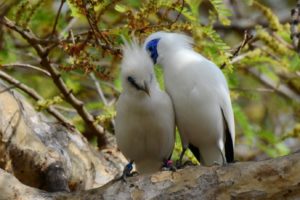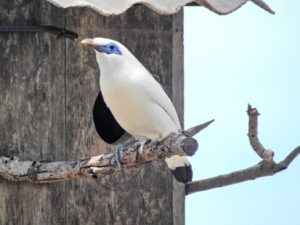Author: Tom Squires and Prof. Stuart Marsden
What project-related developments, either directly or indirectly, took place the past months?
Ecological fieldwork for Bali myna has been ongoing at Bali Barat National Park (BBNP) over the last year in collaboration with the national park staff. Five Indonesian graduates have been helping collect data for the project and many of the national park staff team have contributed by reporting Bali myna sightings and other interesting information, including nesting locations and historic records. Through various sources and our fieldwork, we have upwards of 500 Bali myna sightings; most are recent, but some members of the local community provided records dating back decades.

Colour rings have been attached to some released birds to understand their post-release survival, movement, and establishment as part of the breeding population. To date, 69 Bali myna have been colour ringed, with all but 14 of these released into the wild. We are now in the process of recording these birds regularly. One bird has already been recorded moving between three different security posts in the park and has paired up with a non-ringed bird. These data are already providing us with information about connectivity for Bali myna within the national park.
Two Indonesian graduates came to BBNP in July 2019 and have since completed a vegetation survey of the National Park and its surrounding area. This information is now being used to assess habitat suitability for Bali myna across the area and will be an invaluable tool for the national park to use for their general conservation management responsibilities.
Finally, research examining breeding productivity has just begun and will continue throughout the wet season, which is when Bali myna breed. This work is being carried out by two Indonesian graduate biologists who recently joined the project.
Can you please give us a short status update on objectives and goals you specified in your project proposal?
- Devise robust pre-release, release, and post-release protocols with input and agreement from multiple stakeholders
Two members of the International Advisory Board for Bali myna conservation visited the national park in 2019 to discuss pre-release and release protocols with national park staff. A further pre-release and release protocol workshop is likely to take place in 2020, with the involvement of multiple stakeholders expected. The post-release protocol is a work in progress, and it is expected that recommendations towards this will come out of Tom Squires’ PhD work.
- Introduce a robust system of monitoring and studying released Bali Mynas in BBNP using standard radio-telemetry tracking to determine the key ecological needs of the species
Post-release monitoring is currently being carried out using colour rings to study survival, movement and breeding for a sample of the released population. It is hoped that this work can be expanded in the near future, to include more individuals.
- Support Indonesian students/ecologists to conduct studies of Bali Myna.
To date, capacity building has been very successful as part of the project at Bali Barat. Five Indonesian students and graduates have made valuable contributions: BSc student Panji Gusti Akbar assisted on all aspects of the project for six months, gaining valuable ornithology skills; two recent BSc graduates, Aldina Rahmadhani and Muhammad Arif Romadlon, completed the park-wide vegetation survey; and Mas Untung Sarmawi and Andri Nugroho have recently started a study on Bali myna breeding productivity in the national park.

What activities are planned / scheduled for the next three months?
A study to examine the breeding productivity of the wild population of Bali myna is the focus of fieldwork in BBNP for the next six months. Two Indonesian researchers, Mas Untung Sarmawi and Andri Nugroho have joined the project and are leading this piece of research, in collaboration with MMU and Udayana University, Bali. They will also be monitoring the colour-ringed birds in the national park and recording a new sightings of Bali myna.
With respect to the data already collected from BBNP, data analysis will be carried out over the next three months and the first results are expected to be produced in this time. A habitat classification for the area covered by the vegetation survey will be finalised and shared with all stakeholders involved in Bali myna conservation. Distribution and population estimates will be analysed and included in preliminary results. A more detailed analysis using all data is planned to be undertaken following the completion of the breeding productivity study.
